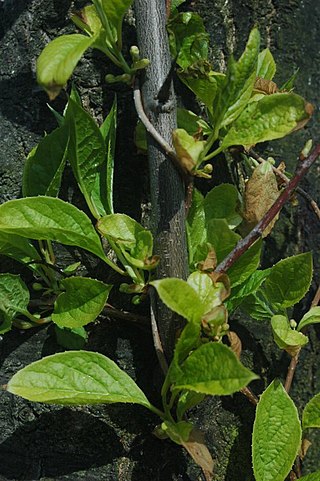
Schisandra, the magnolia vines, is a genus of twining shrubs that generally climb on other vegetation. Various authors have included the plants in the Illiciaceae
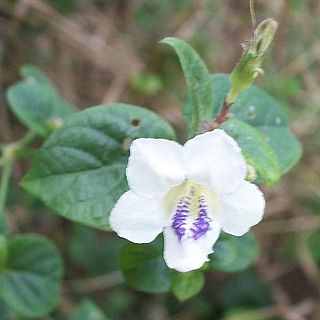
Asystasia gangetica is a species of plant in the family Acanthaceae. It is commonly known as the Chinese violet, coromandel or creeping foxglove. In South Africa this plant may simply be called asystasia.

Elsholtzia ciliata, commonly known as Vietnamese balm, xiang ru (香薷) or kinh giới in Vietnamese, is a plant native to Asia. In the US, it is commonly known as Crested Late Summer Mint. In US Vietnamese grocery stores, it is called Kinh Gioi, Vietnamese Lemon Balm, or Vietnamese Lemon Mint.
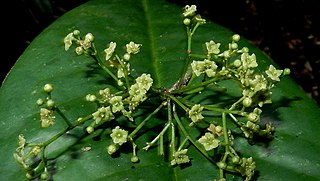
Tontelea is a genus of plants in the family Celastraceae.

Dendrobium parishii is a species of orchid native to Asia.

Cymbidium iridioides, commonly known as the Iris-Like Cymbidium is a species of boat orchid. It is a pseudobulbous epiphyte found from Himalaya to south-central China.

Dendrobium devonianum is a species of orchid. It is native to southern China, the eastern Himalayas, and northern Indochina. It is an epiphyte that grows on tree trunks in mountain forests.

Robiquetia succisa, commonly known as The Abruptly Broken Off Robiquetia, is a small to medium-sized species of pouched orchid found from eastern Nepal to southern China and Indochina.

Hygroryza (watergrass) is a monotyipic genus of Asian flowering plants in the grass family. The only known species is Hygroryza aristata, native to China, Bangladesh, Cambodia, India, Laos, Malaysia, Myanmar, Nepal, Pakistan, Sri Lanka, Thailand, Vietnam.
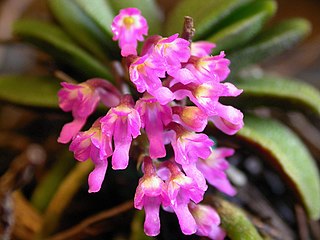
Schoenorchis, commonly known as flea orchids, or 匙唇兰属 in Chinese, is a genus of flowering plants from the orchid family, Orchidaceae. Plants in this genus are small epiphytes with thin roots, thin leafy stems with leaves in two ranks and tiny fragrant, almost tube-shaped flowers with a prominently spurred labellum. There are about twenty five species found from tropical and subtropical Asia to the Western Pacific.

Tofieldia is a small genus of flowering plants described as a genus in 1778. It is widespread across much of Europe, Asia, and North America.

Quercus lanata, the woolly-leaved oak, is a species of Quercus native to southern and southeastern Asia, including India, Bhutan, Nepal, Indochina, and southwestern China. It is a large evergreen tree up to 30 metres tall. The leaves are thick and leathery, green on top but covered in thick wool on the underside. It is classified in subgenus Cerris, section Ilex.

Trema micranthum, the Jamaican nettletree or capulin, is a plant species native to warmer parts of the Western Hemisphere. It has been reported from Mexico, Central America, tropical South America, the Virgin Islands, Jamaica, Cuba, Hispaniola, Puerto Rico, and southern Florida.
Siphocranion is a genus of plants in the family Lamiaceae, first described in 1929. It is native to China, the Himalayas, and northern Indochina.
Actinocarya is a small genus of annual herbs in the family Boraginaceae. Species in the genus are found in Pakistan, China, and India.
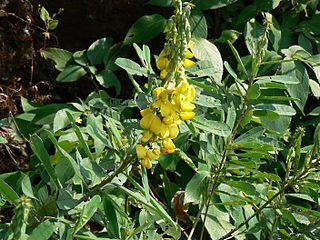
Crotalaria spectabilis, the showy rattlebox or showy rattlepod, is a species of flowering plant in the pea family Fabaceae. It is native to the Indian Subcontinent, southern China, and Southeast Asia. It is a perennial herb that grows up to 0.6–1.5 m (24–59 in) tall. It grows in montane grasslands. It was introduced to most of the world's tropics and subtropics and is now a serious agricultural pest species. It is toxic to livestock, causing liver damage.
Elachyptera is a genus of flowering plants belonging to the family Celastraceae.

Schisandra arisanensis is a climber plant species that is native to China and Taiwan. It grows primarily in the temperate biome. The plant is known for its medicinal properties and its fruit is also edible.
Siphocranion macranthum is a species of flowering plant in the family Lamiaceae. It is commonly known as big-flower siphocranion and tong guan hua in China. It is a perennial herb that is native to Assam, Myanmar, Tibet, Vietnam, South China and East Himalayas. S. macranthum grows in subtropical evergreen and mixed forests.
Digitaria jubata is a species of annual grass in the genus of Digitaria, native to Myanmar, south-central China, and Assam, India.














